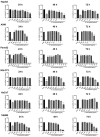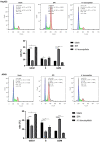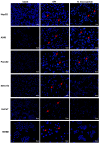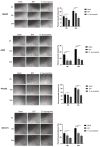Cancer Cell Inhibiting Sea Cucumber (Holothuria leucospilota) Protein as a Novel Anti-Cancer Drug
- PMID: 35215436
- PMCID: PMC8879703
- DOI: 10.3390/nu14040786
Cancer Cell Inhibiting Sea Cucumber (Holothuria leucospilota) Protein as a Novel Anti-Cancer Drug
Abstract
Cancer remains the primary cause of death worldwide. To develop less toxic anti-cancer drugs to relieve the suffering and improve the survival of cancer patients is the major focus in the anti-cancer field. To this end, marine creatures are being extensively studied for their anti-cancer effects, since extracts from at least 10% of the marine organisms have been shown to possess anti-tumor activities. As a classic Chinese traditional medicine, sea cucumbers and compounds extracted from the sea cucumbers, such as polysaccharides and saponins, have recently been shown to exhibit anti-cancer, anti-inflammatory, and anti-oxidant effects. Holothuria leucospilota (H. leucospilota) is a tropical edible sea cucumber species that has been successfully cultivated and farmed in large scales, providing a readily available source of raw materials to support the development of novel marine anti-cancer drugs. However, very few studies have so far been performed on the biological activities of H. leucospilota. In this study, we first investigated the anti-cancer effect of H. leucospilota protein on three cancer cell lines (i.e., HepG2, A549, Panc02) and three normal cell lines (NIH-3T3, HaCaT, 16HBE). Our data showed that H. leucospilota protein decreased the cell viabilities of HepG2, A549, HaCaT, 16HBE in a concentration-dependent manner, while Panc02 and NIH-3T3 in a time- and concentration-dependent manner. We also found that the inhibitory effect of H. leucospilota protein (≥10 μg/mL) on cell viability is near or even superior to EPI, a clinical chemotherapeutic agent. In addition, our data also demonstrated that H. leucospilota protein significantly affected the cell cycle and induced apoptosis in the three cancer cell lines investigated; in comparison, it showed no effects on the normal cell lines (i.e., NIH-3T3, HaCaT and 16HBE). Finally, our results also showed that H. leucospilota protein exhibited the excellent performance in inhibiting cell immigrations. In conclusion, H. leucospilota protein targeted the cancer cell cycles and induced cancer cell apoptosis; its superiority to inhibit cancer cell migration compared with EPI, shows the potential as a promising anti-cancer drug.
Keywords: anti-cancer activity; cell apoptosis; cell migration; marine extractions; sea cucumber protein; targeted effects.
Conflict of interest statement
There are no conflict of interest to declare.
Figures









Similar articles
-
Saponin-rich extracts from Holothuria leucospilota mediate lifespan extension and stress resistance in Caenorhabditis elegans via daf-16.J Food Biochem. 2019 Dec;43(12):e13075. doi: 10.1111/jfbc.13075. Epub 2019 Oct 14. J Food Biochem. 2019. PMID: 31612532
-
Hemolytic and cytotoxic properties of saponin purified from Holothuria leucospilota sea cucumber.Rep Biochem Mol Biol. 2014 Oct;3(1):43-50. Rep Biochem Mol Biol. 2014. PMID: 26989736 Free PMC article.
-
Evolutionarily Ancient Caspase-9 Sensitizes Immune Effector Coelomocytes to Cadmium-Induced Cell Death in the Sea Cucumber, Holothuria leucospilota.Front Immunol. 2022 Jul 14;13:927880. doi: 10.3389/fimmu.2022.927880. eCollection 2022. Front Immunol. 2022. PMID: 35911686 Free PMC article.
-
High-value components and bioactives from sea cucumbers for functional foods--a review.Mar Drugs. 2011;9(10):1761-1805. doi: 10.3390/md9101761. Epub 2011 Oct 10. Mar Drugs. 2011. PMID: 22072996 Free PMC article. Review.
-
Mechanisms of cancer cell killing by sea cucumber-derived compounds.Invest New Drugs. 2017 Dec;35(6):820-826. doi: 10.1007/s10637-017-0505-5. Epub 2017 Sep 18. Invest New Drugs. 2017. PMID: 28920157 Free PMC article. Review.
Cited by
-
A Bibliometric and In Silico-Based Analysis of Anti-Lung Cancer Compounds from Sea Cucumber.Mar Drugs. 2023 Apr 28;21(5):283. doi: 10.3390/md21050283. Mar Drugs. 2023. PMID: 37233477 Free PMC article. Review.
-
Anticancer and anticholesterol attributes of sea cucumbers: An opinion in terms of functional food applications.Front Nutr. 2022 Aug 4;9:986986. doi: 10.3389/fnut.2022.986986. eCollection 2022. Front Nutr. 2022. PMID: 35990338 Free PMC article. No abstract available.
-
Sponge-derived alkaloid AP-7 as a sensitizer to cisplatin in the treatment of multidrug-resistant NSCLC via Chk1-dependent mechanisms.Front Pharmacol. 2024 Jul 9;15:1423684. doi: 10.3389/fphar.2024.1423684. eCollection 2024. Front Pharmacol. 2024. PMID: 39045048 Free PMC article.
-
Antioxidant and Anti-inflammatory Activity of Sea Cucumber (Holothuria scabra) Active Compounds against KEAP1 and iNOS Protein.Bioinform Biol Insights. 2023 Jan 16;17:11779322221149613. doi: 10.1177/11779322221149613. eCollection 2023. Bioinform Biol Insights. 2023. PMID: 36688185 Free PMC article.
-
Marine Migrastatics: A Comprehensive 2022 Update.Mar Drugs. 2022 Apr 19;20(5):273. doi: 10.3390/md20050273. Mar Drugs. 2022. PMID: 35621924 Free PMC article. Review.
References
-
- Hu J., Li Y., Li H., Shi F., Xie L., Zhao L., Tang M., Luo X., Jia W., Fan J., et al. Targeting Epstein-Barr virus oncoprotein LMP1-mediated high oxidative stress suppresses EBV lytic reactivation and sensitizes tumors to radiation therapy. Theranostics. 2020;10:11921–11937. doi: 10.7150/thno.46006. - DOI - PMC - PubMed
MeSH terms
Substances
LinkOut - more resources
Full Text Sources
Medical
Research Materials
Miscellaneous

